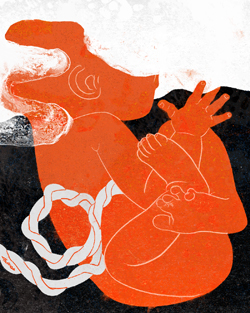SUMMER 2013 CONTENTS
Home
Hiding in plain sight
The environmental factor
Priming the pumps
Debugging Dhaka’s water
Close encounters
How we're crossing paths with disease-bearing pests
Street smarts
Using citizen-scientists to fight for healthier neighborhoods
Beyond hurricane heroics
What Sandy should teach us all about preparedness

DOWNLOAD PRINTABLE
ISSUE (PDF)


Bad airPollution and pregnancy
Breathing traffic pollution in early pregnancy is linked to higher risk for certain serious birth defects — a new finding that helps clarify a public health question that scientists have struggled with for more than a decade.
Illustration by Jacob Thomas

Prior studies of air pollution and birth defects date back as far as 2002, but their inconsistent methods produced a confusing picture: Researchers examined many different geographic regions and pollutants, most studies assessed only heart defects, and none evaluated what mothers were breathing during early pregnancy — the period when birth defects are most likely to develop. Results were mixed, with some but not all demonstrating a pollution-birth defect connection.
Enter a team of scientists from Stanford, the University of California-Berkeley and Sonoma Technology Inc. The UC-Berkeley researchers were already using data from federally mandated air-quality monitoring programs to examine links between traffic pollution and childhood asthma in California’s smoggy San Joaquin Valley. Stanford’s Gary Shaw, PhD, joined the team to add expertise from his work connecting birth defects to environmental factors such as maternal nutrition.
“Birth defects affect one in every 33 babies, and about two-thirds of these defects are due to unknown causes,” says Shaw, the senior author of the new research. “When these babies are born, they bring into a family’s life an amazing number of questions, many of which we can’t answer.” Shaw is a professor of pediatrics in neonatal and developmental medicine. His team looked at five birth defects and six measures of traffic-related air pollution.
“It’s still unclear which birth defects may be associated with air pollution, so we started with the ones that we thought had the most potential impact from the environment,” says the study’s lead author, Amy Padula, PhD, a postdoctoral scholar in pediatrics at Stanford.
The team found a link between traffic-related pollution and brain and spine malformations. The research, published online March 28 in the American Journal of Epidemiology, evaluated 806 women who had a pregnancy affected by a birth defect between 1997 and 2006, and 849 women who had healthy babies during the same period.
All women studied resided in the San Joaquin Valley during the first eight weeks of their pregnancies, a window of time when many birth defects develop. Compared with women with the lowest carbon monoxide exposure, those who breathed the highest levels were nearly twice as likely to have a baby with anencephaly (the absence of a brain) or spina bifida (the failure of the spinal cord to close during development), which can lead to paralysis of the lower body and curvature of the spine, among other problems. Nitrogen oxide and nitrogen dioxide exposures were also linked to increased risk for these defects; women with the highest nitrogen oxide exposure had nearly three times the risk of having a pregnancy affected by anencephaly, for example. Further studies are needed to examine the combined effects of multiple pollutants, and to examine other pollutants.
The researchers are also hoping that policymakers will consider this study when they assess limits for air pollutants. This study offers new ammunition to fight for that, Shaw says. “Clearly there are multiple reasons to improve the air, but the well-being of our newborns is a fairly hot button to push.”
— Erin Digitale

